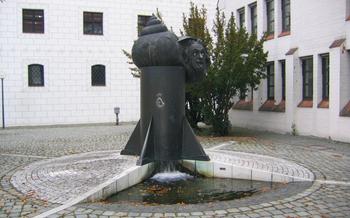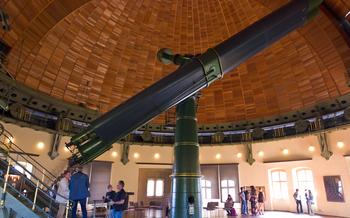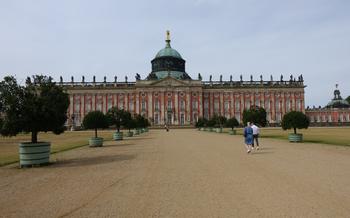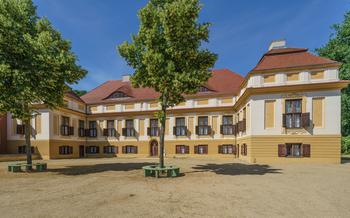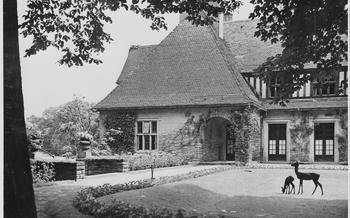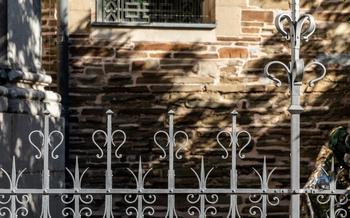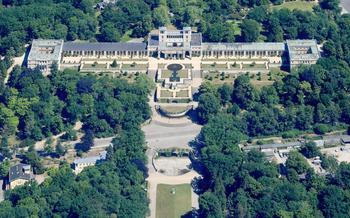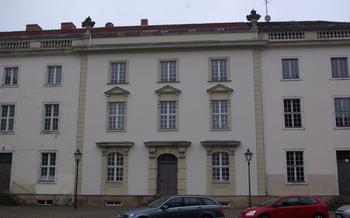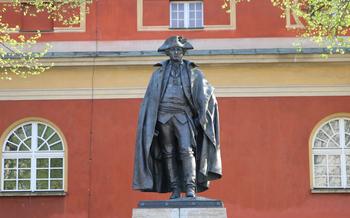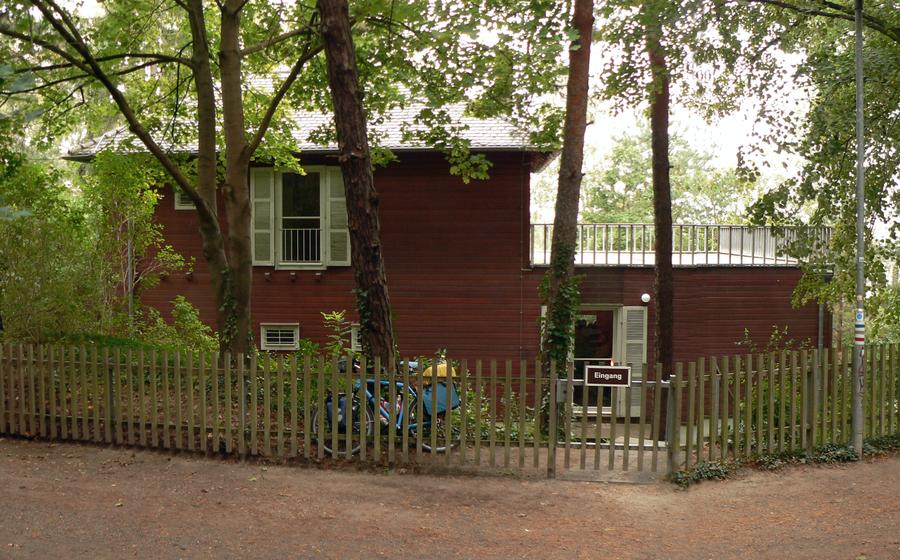
The Einsteinhaus Caputh
- Historical Significance
- Architectural Features
- Personal Artifacts
- Scientific Insights
- Guided Tours
- Interactive Exhibits
- Einstein's Study
- Einstein's Library
- Einstein's Garden: A Sanctuary for Inspiration
- Einstein's Boat
- Einstein's Legacy
- The Surrounding Area
- Accessibility
- Events and Workshops
- Insider Tip: Double the Scientific Fun
Historical Significance
Albert Einstein's former summer home in Caputh, now known as the Einsteinhaus Caputh, offers a unique opportunity to explore the life and work of one of the most influential scientists in history. Step into the world of Albert Einstein and discover his groundbreaking contributions to physics, which revolutionized our understanding of the universe. Learn about his theories of relativity, his impact on modern science, and the profound legacy he left behind.
Immerse yourself in the history of the house, which served as Einstein's summer retreat from 1932 until his emigration to the United States in 193Explore the rooms where Einstein lived and worked, gaining insights into his daily life and creative process. Delve into the stories behind the house's restoration, which meticulously preserved its original character and transformed it into a museum dedicated to Einstein's life and achievements.
Architectural Features
The Einsteinhaus Caputh stands out for its unique architectural design, blending traditional and modern elements. Built in 1929, the house reflects Einstein's interest in combining functionality with aesthetics. The exterior features a simple, cubic form with clean lines, typical of the Bauhaus style popular at the time. However, the house also incorporates traditional elements, such as the pitched roof and dormer windows, which nod to the local architectural heritage.
Inside, the house is characterized by its spacious and light-filled rooms. Large windows offer stunning views of the surrounding garden and lake, creating a sense of harmony between the interior and exterior spaces. The living areas are arranged in an open-plan layout, allowing for easy flow and interaction.
Visitors can explore the different rooms of the house, each with its own unique character. The living room features a cozy fireplace and comfortable seating, where Einstein and his family would gather for relaxation and conversation. The dining room showcases a long wooden table, where Einstein often hosted dinner parties with friends and colleagues. The study, perhaps the most iconic room in the house, is where Einstein spent countless hours working on his theories, surrounded by his books and scientific instruments.
The Einsteinhaus Caputh has undergone several restoration efforts to preserve its original character and maintain its historical integrity. These efforts have been guided by meticulous research and attention to detail, ensuring that the house remains a faithful representation of Einstein's life and work.
Personal Artifacts
The Einsteinhaus Caputh offers a unique opportunity to see personal items and belongings that belonged to Albert Einstein, providing a glimpse into his daily life and habits. Visitors can admire furniture that Einstein used, books from his extensive library, and scientific instruments that played a crucial role in his groundbreaking discoveries. Each artifact tells a story, revealing Einstein's passions, interests, and the evolution of his scientific thought.
One of the most fascinating artifacts is Einstein's writing desk, where he spent countless hours scribbling down his theories and calculations. The desk is adorned with family photographs, scientific papers, and personal mementos, offering a glimpse into Einstein's working environment. Visitors can almost imagine Einstein sitting in his chair, contemplating the mysteries of the universe and penning down his revolutionary ideas.
Another highlight of the collection is Einstein's violin, a constant companion throughout his life. Music played a significant role in Einstein's life, and he found solace and inspiration in playing the violin. Visitors can admire the instrument and learn about the connection between Einstein's scientific work and his love of music.
Through these personal artifacts, visitors gain a deeper understanding of Einstein's life beyond his scientific achievements. They discover the human side of a genius, his passions, and his daily routine, providing a more well-rounded perspective on one of the most influential minds in history.
Scientific Insights
Albert Einstein's theories revolutionized our understanding of the universe. At the Einsteinhaus Caputh, visitors can gain insights into his groundbreaking work and the implications of his discoveries. Learn about the theory of relativity, which challenged our traditional notions of space, time, and gravity. Explore the significance of Einstein's mass-energy equivalence equation, E=mc², which revealed the relationship between energy and mass. Discover the thought experiments and experiments that led Einstein to his groundbreaking theories, such as the famous double-slit experiment. Understand how Einstein's work laid the foundation for modern physics and continues to influence scientific research and technological advancements. Through interactive exhibits and guided tours, visitors can delve into the complexities of Einstein's theories and gain a deeper appreciation for his scientific genius.
Guided Tours
Take advantage of the guided tours offered by knowledgeable staff to learn more about Einstein and his life. These tours provide an insider's perspective on the house and its history, as well as Einstein's scientific achievements. Choose from different tour options that cater to various interests and levels of knowledge.
Standard Tour:
This basic tour provides a comprehensive overview of Einstein's life and work. It covers the history of the house, Einstein's daily routine, and his scientific discoveries. The tour is suitable for visitors of all ages and backgrounds.
In-Depth Tour:
For those seeking a deeper understanding of Einstein's theories, the in-depth tour delves into the complexities of his scientific work. It explores the concepts of relativity, the photoelectric effect, and the theory of gravitation. The tour is recommended for visitors with a background in physics or a strong interest in science.
Family Tour:
Designed for families with children, the family tour engages young minds with interactive activities and storytelling. It introduces Einstein's life and work in a fun and accessible way, making science enjoyable for children of all ages.
Group Tours:
For groups of 10 or more, customized tours can be arranged to accommodate specific interests or requirements. Group tours offer a flexible and tailored experience for educational institutions, scientific organizations, and corporate teams.
Interactive Exhibits
The Einsteinhaus Caputh offers a range of interactive exhibits that bring Einstein's theories to life and make them accessible to visitors of all ages. These exhibits are designed to engage and educate, providing a fun and interactive way to learn about Einstein's groundbreaking work.
One of the highlights of the interactive exhibits is the "Einstein's Universe" section, which features a large-scale model of the solar system. Visitors can use touchscreens to manipulate the model, changing the positions of the planets and observing how they move in relation to each other. This interactive display helps visitors to visualize the complex interactions between celestial bodies and understand the principles of gravity.
Another popular exhibit is the "Light and Relativity" section, which explores the fascinating concepts of light and relativity. Visitors can conduct hands-on experiments to demonstrate the properties of light and learn about the bending of light around massive objects, a key prediction of Einstein's theory of general relativity.
These interactive exhibits are not just educational, but also entertaining, making them a great way to learn about science in a fun and engaging way. Whether you're a science enthusiast or simply curious about Einstein's work, the interactive exhibits at the Einsteinhaus Caputh are sure to captivate and inspire.
Einstein's Study
Step into Einstein's study, a sanctuary of intellectual pursuits and groundbreaking scientific discoveries. This room, where Einstein spent countless hours immersed in his work, exudes an aura of genius and creativity. As you enter, imagine Einstein sitting at his desk, scribbling complex equations on a notepad, his mind racing with ideas that would revolutionize our understanding of the universe.
The study is a testament to Einstein's meticulousness and dedication to his work. His desk, adorned with papers, books, and scientific instruments, provides a glimpse into his thought process and the intricate web of ideas that led to his groundbreaking theories. Surrounded by bookshelves filled with volumes on physics, mathematics, and philosophy, Einstein found inspiration and fuel for his scientific explorations.
Take a moment to sit in Einstein's chair and contemplate the profound impact his work has had on our understanding of the cosmos. Imagine the excitement and satisfaction he must have felt as he arrived at groundbreaking insights that would change the course of scientific history. The study is a place where the spirit of scientific inquiry and discovery still lingers, inviting visitors to connect with Einstein's brilliance and the legacy he left behind.
Einstein's Library
Delve into the mind of Albert Einstein by exploring his extensive library, a treasure trove of knowledge that shaped his groundbreaking theories. Browse through the shelves filled with books on physics, mathematics, philosophy, and other subjects that captivated Einstein's curiosity. Discover the influences and inspirations that fueled his revolutionary ideas. Learn about the books that sparked his imagination and led to his paradigm-shifting discoveries.
Imagine Einstein sitting in his study, surrounded by these volumes, immersing himself in the world of scientific exploration. Each book tells a story of Einstein's intellectual journey, revealing the sources of his inspiration and the foundations of his scientific achievements. From classic works of physics to contemporary scientific journals, Einstein's library provides a glimpse into the mind of a genius.
Take your time to peruse the titles, marveling at the breadth and depth of Einstein's interests. Discover the books that challenged his thinking, provoked his curiosity, and ultimately led to his groundbreaking theories of relativity. Step into Einstein's world and experience the intellectual journey that transformed our understanding of the universe.
Einstein's Garden: A Sanctuary for Inspiration
Einstein's garden was a special place for him, where he found solace, inspiration, and a connection with nature. The garden, which was lovingly tended by Einstein himself, featured a variety of flowers, trees, and shrubs, creating a tranquil oasis that surrounded his home.
Imagine Einstein strolling through his garden, admiring the vibrant colors of the flowers and the lush greenery of the trees. He would often sit among the plants, contemplating the mysteries of the universe and seeking inspiration for his scientific work. The garden provided him with a peaceful retreat, where he could escape the pressures of his scientific pursuits and simply enjoy the beauty of nature.
Take some time to explore Einstein's garden, and imagine the great physicist walking among the plants, deep in thought. Let the tranquility of the garden wash over you, and feel the inspiration that Einstein himself must have felt as he wandered through this special place.
Einstein's Boat
In addition to his scientific pursuits, Albert Einstein had a passion for sailing. He owned a small sailboat named "Tümmler," which he used to navigate the nearby Templiner See lake. Einstein found solace and inspiration while sailing, often using the tranquil waters as a backdrop for his contemplation. Imagine Einstein sitting at the helm of his boat, his hair blowing in the wind as he gazed out at the horizon, lost in thought. Sailing provided Einstein with a sense of freedom and escape from the complexities of his scientific work. It allowed him to connect with nature and find peace and rejuvenation. Today, visitors to the Einsteinhaus Caputh can see the boat that Einstein sailed, which is displayed on the grounds of the property. It serves as a reminder of Einstein's love of the outdoors and his appreciation for the beauty and wonder of the natural world.
Einstein's Legacy
Albert Einstein's work has had a profound impact on modern physics and our understanding of the universe. His theories of relativity revolutionized our understanding of space, time, and gravity, and his work on quantum mechanics laid the foundation for much of modern physics. Einstein's insights have led to the development of new technologies, such as lasers, atomic clocks, and GPS, and have shaped our understanding of the cosmos, from the smallest subatomic particles to the vastness of the universe.
Einstein's legacy extends beyond his scientific achievements. He was a passionate advocate for peace and international understanding, and his work has inspired countless people to pursue careers in science and technology. Einstein's name has become synonymous with genius and creativity, and his image has been used in popular culture to represent the ultimate intellectual.
Visiting the Einsteinhaus Caputh is an opportunity to learn more about the life and work of this extraordinary scientist and to appreciate his enduring legacy. Through the personal artifacts, interactive exhibits, and guided tours, visitors can gain a deeper understanding of Einstein's contributions to science and his impact on the modern world.
The Surrounding Area
The Einsteinhaus Caputh is located in the charming town of Caputh, situated on the shores of the Templiner See lake. Take advantage of your visit to explore the surrounding area, which offers a variety of attractions and activities.
Stroll through the picturesque streets of Caputh, admiring the historic buildings and quaint shops. Discover the beauty of the surrounding countryside with scenic walks along the lake or bike rides through the lush forests. If you're feeling adventurous, rent a boat and explore the Templiner See lake, enjoying the tranquility and serenity of the water.
Beyond Caputh, the region offers even more attractions. Visit the nearby Babelsberg Film Studio, one of the oldest large-scale film studios in the world, and take a tour to learn about its history and see where famous movies have been filmed. Don't miss the Sanssouci Palace, a UNESCO World Heritage Site, with its stunning gardens and opulent architecture.
With so much to see and do in the surrounding area, you can easily spend a day or two exploring the region and immersing yourself in its rich history and culture.
Accessibility
The Einsteinhaus Caputh is committed to ensuring that all visitors, regardless of their abilities, can enjoy and learn from the museum. Accessibility features include:
-
Wheelchair access: The museum is fully wheelchair accessible, with ramps and elevators to all floors.
-
Accessible restrooms: There are accessible restrooms on both floors of the museum.
-
Audio guides: Audio guides are available in German and English, and can be used with a wheelchair or other assistive device.
-
Tactile exhibits: There are several tactile exhibits throughout the museum, which allow visitors with visual impairments to experience Einstein's work in a hands-on way.
-
Sign language interpretation: Sign language interpretation can be arranged for guided tours with advance notice.
Visitors with disabilities are encouraged to contact the museum in advance to discuss their specific needs and to ensure a smooth and enjoyable visit.
Events and Workshops
The Einsteinhaus Caputh hosts a variety of events and workshops throughout the year, offering visitors opportunities to engage with experts, participate in discussions, and deepen their understanding of Einstein's life and work.
Lectures and talks by renowned physicists, historians, and science communicators shed light on Einstein's theories, his impact on modern science, and the latest developments in physics. These events provide a platform for attendees to ask questions, share ideas, and gain insights into the world of physics.
Hands-on workshops offer a unique opportunity to explore Einstein's theories through interactive activities and experiments. Participants can build their own models of the solar system, conduct experiments on light and gravity, and learn about the principles of relativity in a fun and engaging way.
Special events and workshops are also organized for families and children, allowing them to discover the wonders of science in a playful and interactive environment. These events feature storytelling sessions, science shows, and hands-on activities designed to spark curiosity and inspire the next generation of scientists.
By participating in these events and workshops, visitors can gain a deeper understanding of Einstein's legacy, engage with experts in the field of physics, and foster their own interest in science and exploration.
Insider Tip: Double the Scientific Fun
For an immersive scientific experience, consider purchasing the combined ticket that grants you access to both the Einsteinhaus Caputh and the nearby Albert Einstein Science Park. This money-saving option allows you to explore Einstein's former summer home and delve into the world of science and discovery at the interactive science park. Spend a full day immersed in Einstein's legacy, unraveling the mysteries of the universe, and engaging in hands-on activities that bring scientific concepts to life. If you're visiting during the summer months, the Einsteinhaus Caputh's garden is in full bloom, providing a picturesque backdrop for your exploration.
